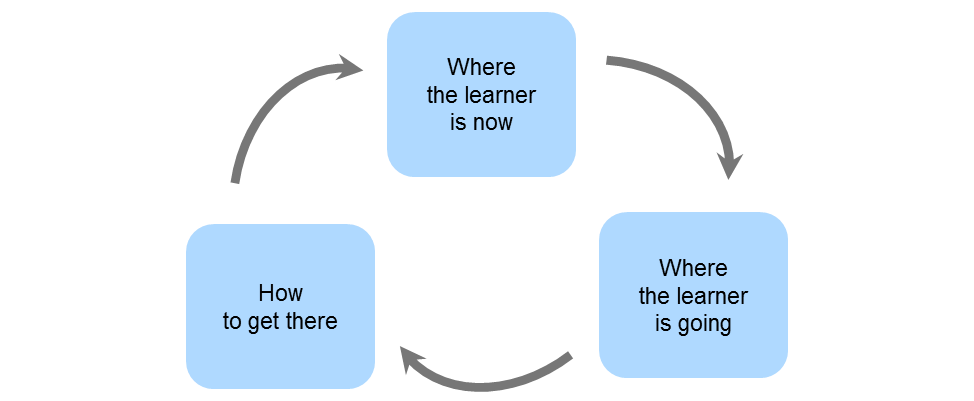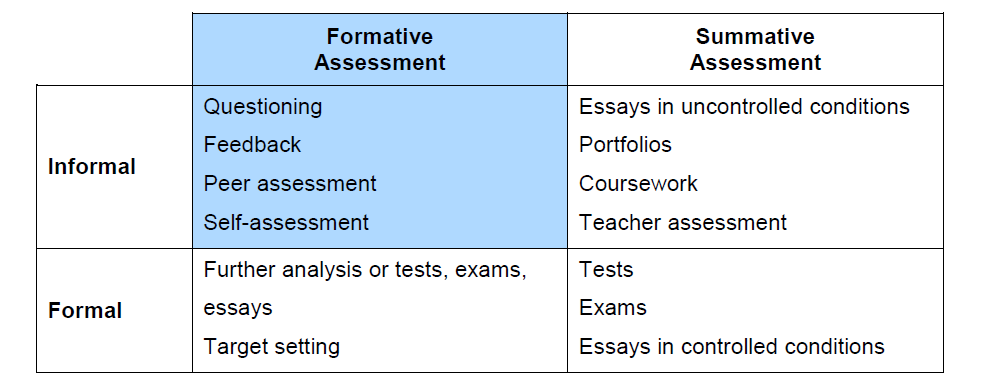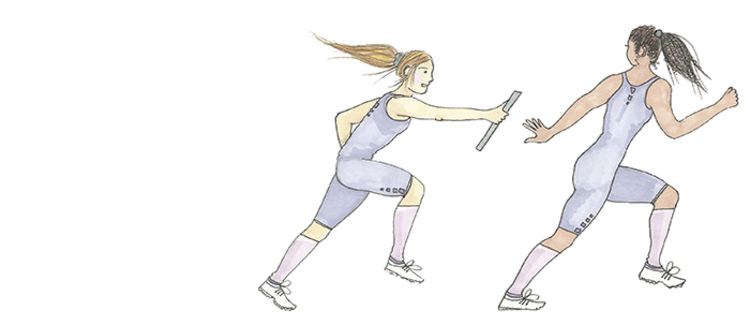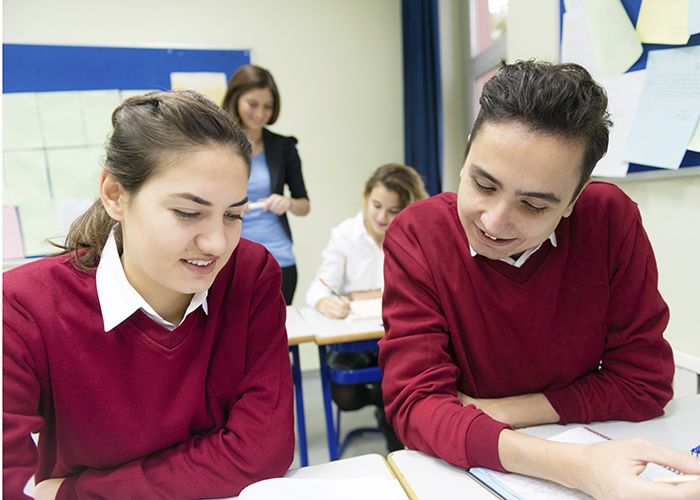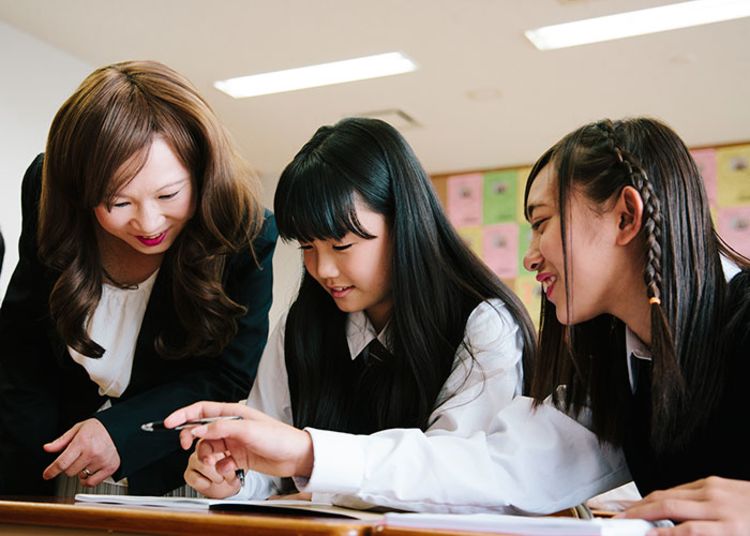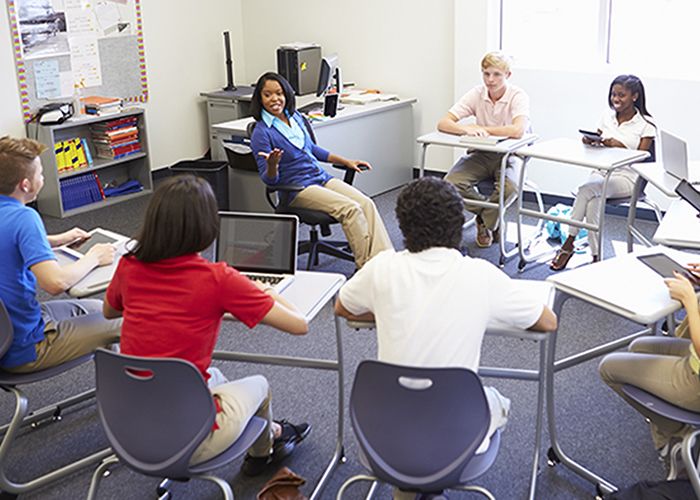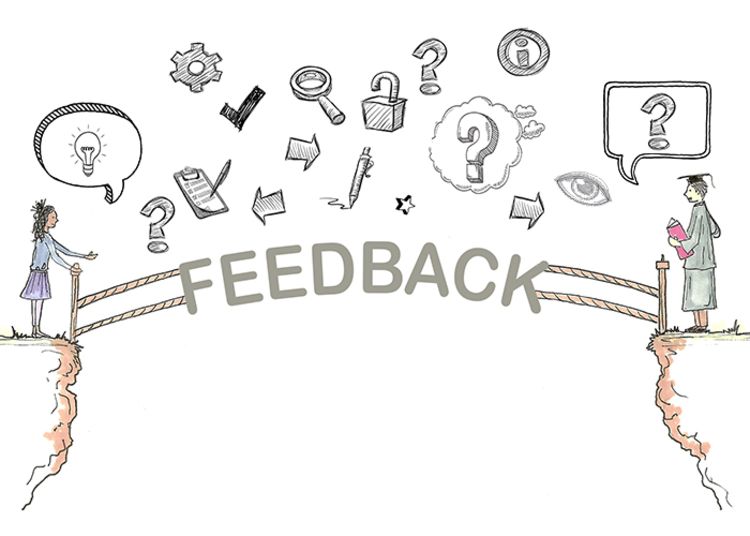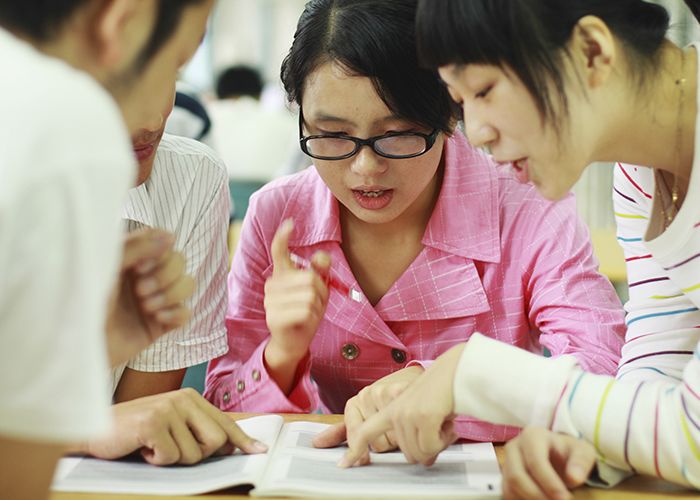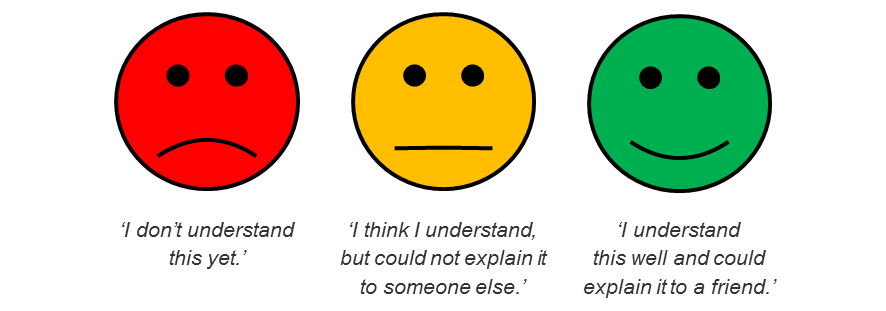Getting started with Assessment for Learning
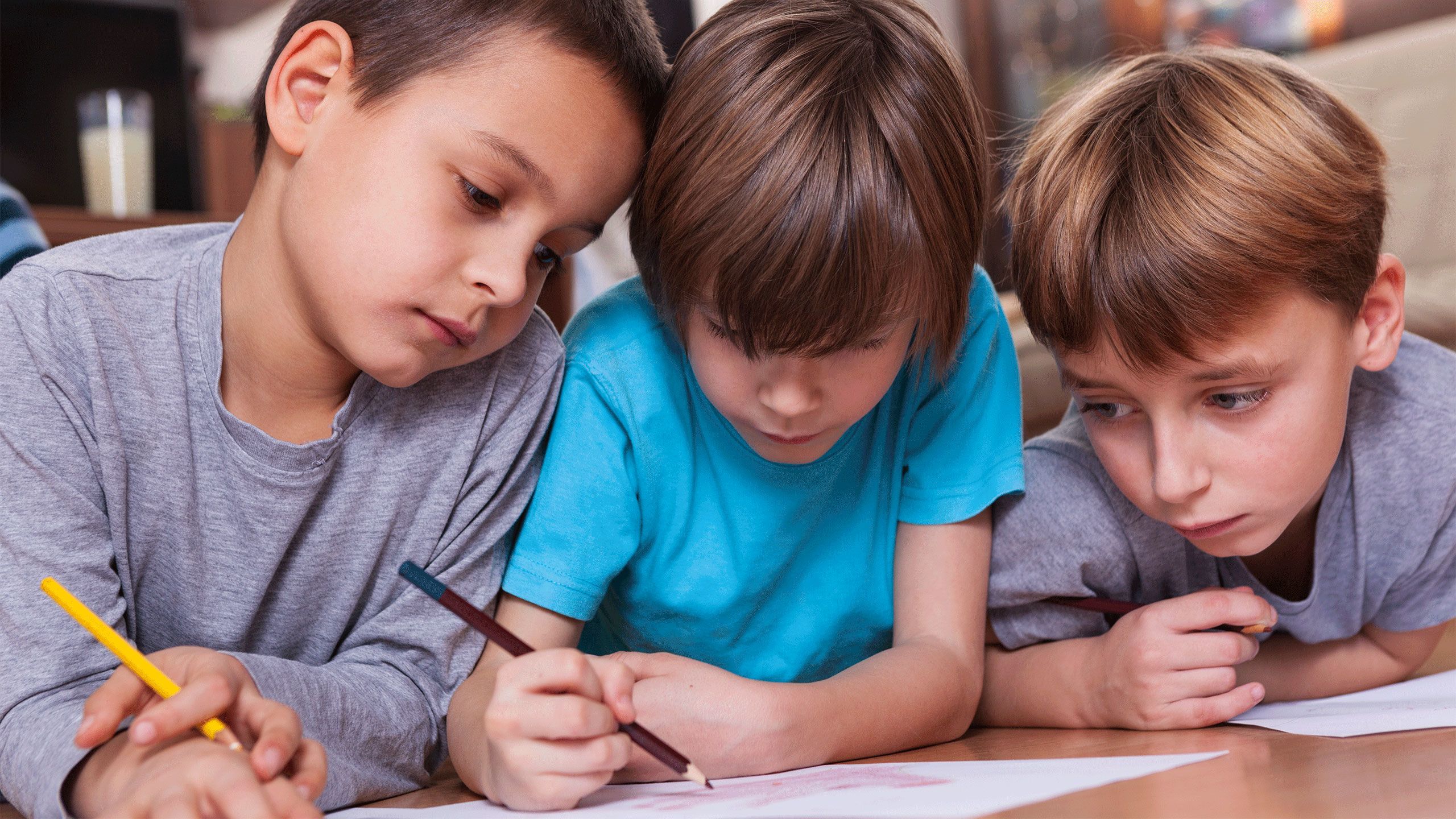
What is assessment for learning?
Assessment for learning (AFL) is an approach to teaching and learning that creates feedback which is then used to improve students’ performance. Students become more involved in the learning process and from this gain confidence in what they are expected to learn and to what standard.
One way of thinking about AFL is that it aims to ‘close the gap’ between a learner’s current situation and where they want to be in their learning and achievement. Skilled teachers plan tasks which help learners to do this.
AFL involves students becoming more active in their learning and starting to ‘think like a teacher’. They think more actively about where they are now, where they are going and how to get there.
Effective teachers integrate AFL in their lessons as a natural part of what they do, choosing how much or how little to use the method. AFL can be adapted to suit the age and ability of the learners involved.
AFL strategies are directly linked to improvements in student performance in summative tests and examinations. Research shows that these strategies particularly help low-achieving students to enhance their learning.
AFL and the relationship with formative and summative assessment
Traditionally, AFL has been closely associated with formative assessment because practices such as questioning and providing feedback help ‘form’ or ‘shape’ student learning. This differs from summative assessment which typically is an attempt to measure student attainment at the end of a period of learning.
The following table, based on the UK’s National Foundation for Educational Research report (NFER 2007), classifies types of formative and summative assessment as either formal or informal.
It can be argued that all of the assessment strategies in this table support AFL if their ultimate use is to help the student progress in terms of their learning.
A good example of using a summative assessment strategy in an AFL context is where a test or exam is used to identify a lack of understanding (e.g. in a particular area of the syllabus) and subsequently targets are set to rectify this.
"In AFL, it is the purpose of assessment, rather than the nature of it, that is important."
There are five main processes that take place in assessment for learning:
(i) Questioning enables a student, with the help of their teacher, to find out what level they are at.
(ii) The teacher provides feedback to each student about how to improve their learning.
(iii) Students understand what successful work looks like for each task they are doing.
(iv) Students become more independent in their learning, taking part in peer assessment and self-assessment.
(v) Summative assessments (e.g. the student’s exam or portfolio submission) are also used formatively to help them improve.
In the rest of this unit, we will look at the basics of AFL in more detail. We will examine the theory behind AFL and some of the misconceptions that people often have. Then we will focus on some practical strategies you can use in the classroom. We will also hear from both learners and teachers about their experiences of AFL in the classroom.
Throughout the unit, you will be encouraged to reflect upon AFL and to think about how you can integrate it into your own classroom practice. At the end of the unit there is a glossary of key words and phrases.
In this video, teacher trainer James Woodworth discusses the relationship between assessment for learning and assessment of learning:
What is the theory behind AFL?
AFL helps in making understanding and knowledge, as John Hattie describes it, ‘more visible’. AFL helps learners understand what excellence looks like and how they can develop their own work to reach that level.
Feedback has a positive effect on learner achievement. In John Hattie’s seminal work on educational effectiveness, Visible Learning for Teachers (2011), Hattie ranked feedback strategies 10th out of 150 factors that bring about significant improvements in learner outcomes. This was particularly true if the strategies involved feedback about the learner’s own work.
Black and Wiliam argue that if teachers use formative assessments as part of their teaching, students can learn at approximately double the rate. Hattie's research also shows that using formative assessment in the classroom brings about real-world differences in learner achievement.
Attribution theory
Attribution theory says that people explain their own successes or failures to themselves in different ways. Some factors that lead to success or failure are controllable and some are not.
Examples of factors that a learner might feel able to control include how much effort they make and how interested they are in the subject. Non-controllable factors include luck or the amount of help the learner receives from the teacher.
Learners who take part in self-assessment (as part of AFL) learn to attribute failures to controllable factors. For example, a learner doing badly on a homework assignment might realise that they focused on the wrong subject matter. Because the choice of subject matter was in their control, they can review, edit and improve the work. Being in control in this way will boost the learner’s confidence and achievement.
Metacognition
Metacognition is a term used to describe ‘thinking about thinking’ and supports the idea of self-assessment. Metacognition suggests that all learners need to be able to reflect on their own learning, to understand how they learn best and to reinterpret any new knowledge, skills and conceptual understandings that they have acquired.
Learning happens when students are given opportunities to build upon previous knowledge and experiences. Research consistently shows that only telling learners what they need to know is much less effective than helping them construct meaning for themselves.
Want to know more?
In this video, Dylan Wiliam talks about his work on AFL and how it helps to improve learner achievement.
What are the benefits of AFL?
AFL improves learner outcomes
Research shows that effective formative assessment is one of the most important contributors to success in summative assessment. This is because learners have a clear idea of what good work looks like and what they need to do to reach this standard.
AFL increases confidence
AFL helps create a sense of self-efficacy (a learner’s confidence in their ability to reach targets through hard work and determination). This is an essential quality for learners to develop. Self-efficacy will help them succeed throughout their life, both professionally and personally.
A student who receives a poor grade for a test may withdraw from learning, preferring to be thought ‘lazy’ rather than ‘stupid’. With an AFL approach, teachers give learners task-specific feedback that focuses on the work rather than ego-specific feedback that focuses on personal qualities of the learner. This encourages every learner to feel that they can improve. You can find out more about different types of feedback in this article from the American Psychological Association http://www.apa.org/education/k12/using-praise.aspx
AFL techniques, such as peer feedback, can help more able learners to reinforce their learning by explaining ideas to less able classmates. Furthermore, peer feedback helps learners to develop diplomacy and communication skills that will be essential in many aspects of later life.
AFL increases independence
AFL enables learners to become less passive in the classroom, especially when combined with other methods that promote this type of approach, such as active learning techniques. Students will develop the ability to assess themselves and to take responsibility for their own learning. This supports the development of the Cambridge learner attributes which says that Cambridge learners are confident, responsible, reflective, innovative and engaged. An AFL approach also helps students to become enthusiastic life-long learners.
AFL also helps teachers. When students are taking a more active role in their learning, teachers have more time to talk to them individually. In addition, teachers have more time to reflect on what is going well in their lesson and what can be improved.
AFL changes the culture of the classroom
Carol Dweck argues that high-achieving learners avoid taking risks because they are afraid of making mistakes. This reduces the amount they can learn. An AFL approach helps to create a supportive and cooperative classroom. In this environment, everyone, including the teacher, should feel able to try new things without worrying that they might fail. If the teacher presents mistakes as an opportunity for learning, this will help every student to reach their full potential. Students will start to see that by learning from failure, they can improve outcomes in the future.
Summary
In this video, teacher trainer James Woodworth discusses some of the benefits of using AFL strategies in the classroom.

Six misconceptions about AFL
‘Assessment and testing are the same thing’
There are lots of different ways to assess a learner. This includes formal testing. However, a teacher will use a variety of formal and informal assessment activities throughout the learning process. Any activity which checks how well a student is learning is assessing that student’s learning. Information from these assessment activities is used to adapt teaching and learning approaches, which leads to improvements in learner outcomes.
‘Teachers using AFL will lose control of their class’
AFL requires teachers to allow learners to discuss work between themselves in class. This will naturally involve some talking and, therefore, some noise. However, the teacher remains in control. The teacher decides when to let the class talk and when to ask them to be quiet. It is also often the case that behaviour usually improves when learners’ understanding improves.
‘Peer feedback means students chatting to each other’ rather than working on a task'
Peer feedback can only take place when learners have a clear idea about what they are discussing and the areas that they should (and should not) be giving feedback about. Learners should also think about, and understand, how they are judging each other’s work. The more learners engage with, and think deeply about, the success criteria, the more they are able to give useful feedback to their peers.
‘Examinations are the only type of assessment that matter’
Learners need to take formal exams to get qualifications to progress through their education. Assessment for learning gives teachers more information throughout the year. One of the results of an AFL approach is that it helps students to do better in summative assessment. The two are linked and both inform future learning.
‘Assessment is a one-way process: teachers give students feedback about their work’
The most effective feedback is a dialogue. Teachers can learn more about their learners’ progress when their learners take a more active role in assessing their own performance. For example, through self-assessment learners can identify what they need help with and then discuss this with their teacher.
‘Work should always be given a grade or mark’
In some circumstances, a grade will be given as part of teacher feedback. However, research suggests that learners will often just read the grade and ignore the comments. Where teachers want to give a grade, it is often more effective for learners to read feedback and comments first, and then edit their work before they see a grade.
What are the challenges of AFL?
Misunderstanding
The word ‘assessment’ often leads to confusion, because it is usually used to refer to summative testing. AFL mainly focuses on the use of informal formative assessment to improve learning. Although teachers and learners can also learn from their work in formal summative test papers, this is not the main emphasis of AFL.
Training and time
Introducing AFL into a school or classroom takes time. It sometimes requires additional professional training, and it changes to the ways that teachers interact with their learners.
Fear of change
Teachers and learners may fear that the changes required in their classroom practice will not help them. High-achieving and diligent learners may find it hard to look for faults and mistakes in their work and thinking. They may feel that they do not want to show any sign of weakness or failure.
Getting it right
Giving feedback to learners about their work can have a negative effect as well as positive. A teacher must choose their words carefully when giving feedback. If the teacher gives the impression that only the teachers can provide the right answer, learners will find it hard to be independent.
Culture
Sometimes teachers are judged solely on their ability to get good results in high-stakes summative assessments. Teachers may feel that they do not have time to do activities that do not seem directly linked to final examination grades. However, using feedback to modify instruction and help learners to better understand assessment objectives will improve exam results.
"…using feedback to modify instruction and help learners to better understand assessment objectives will improve exam results."
Want to know more?
In this thought-provoking article, Carol Dweck discusses the effect of praise on learners.
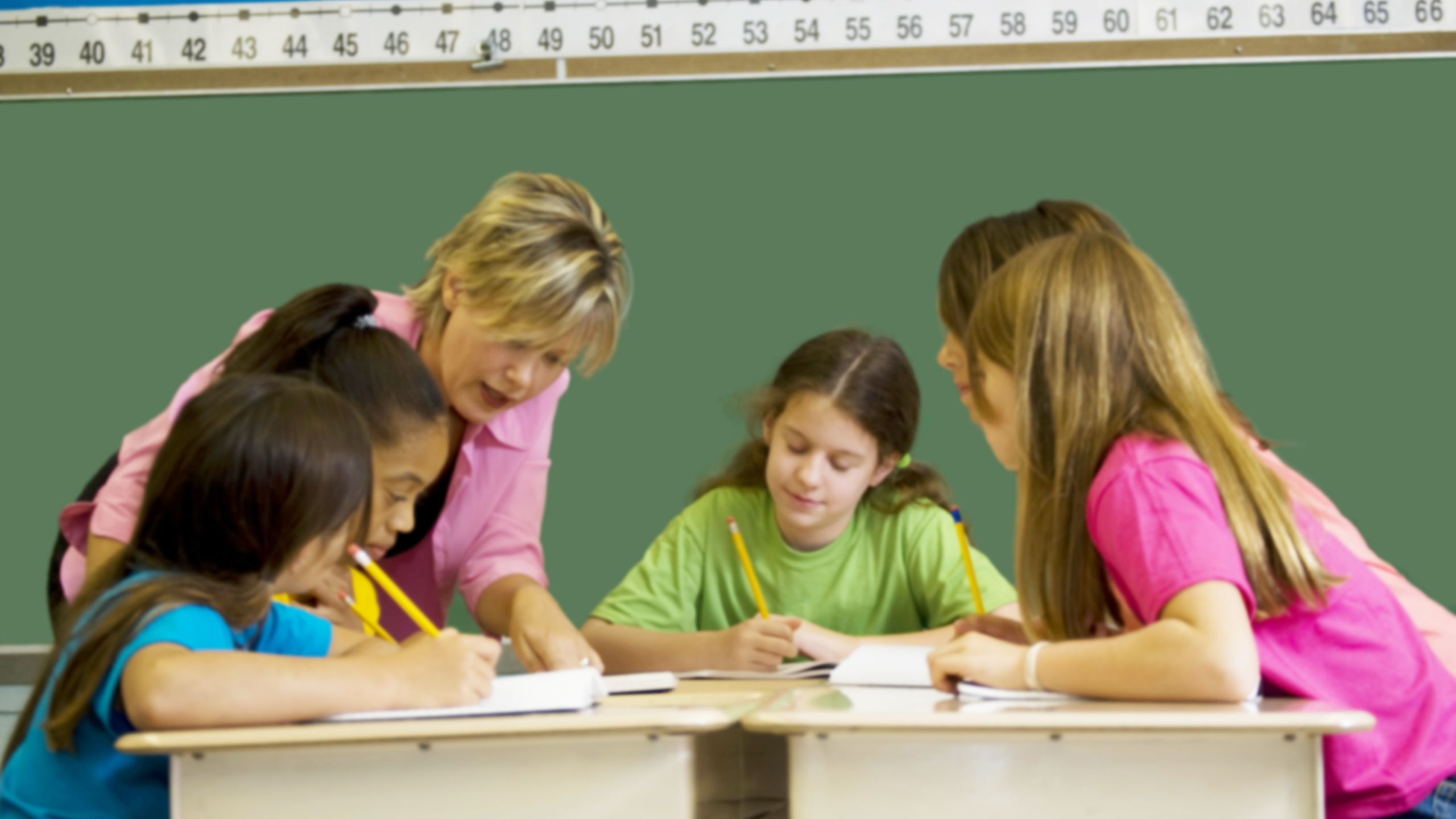
Assessment for learning in practice
AFL emphasises the creation of a learner-centred classroom with a supportive atmosphere, where students are not afraid to make mistakes and learn from them.
We are going to look at five approaches or strategies that you can use in a lesson or programme of study.
1. Questioning
Questions are a quick and important way of finding out what your learner understands about a subject. You can use this information to plan their teaching.
There are two main types of question: closed and open.
A closed question requires a short answer, such as remembering a fact. The answer is usually right or wrong.
For example, a Geography teacher might ask: ‘What is the capital of Peru?’
On average, teachers only wait 0.9 seconds after asking a question before taking an answer from a learner. Mary Rowe suggests that increasing ‘wait time’ to three seconds improves the quality of answers.
One way to help increase ‘wait time’, and to ensure the whole class is actively engaged, is to ask your learners to write down the answer to a closed question on a piece of paper, mini whiteboard or tablet, and hold it up. This immediately gives you feedback about who understands, who does not, and therefore what the next steps in the learning might be.
A good strategy to use if a learner gets the answer wrong is to make this into a positive event. You could say: ‘I’m glad you said that, as I’m sure lots of other students have the same misunderstanding.’
In an AFL classroom, finding out what learners do not know is as valuable as finding out what they do know. This knowledge will help you to see what material your learners need to spend extra time on to make sure that they all understand.
Open questions need longer answers, and often require the learner to provide an opinion.
E.g. A Physics teacher might ask: ‘What will happen to the flow of water through a hose pipe if a smaller nozzle is fitted to it? Explain how this relates to the study of voltage, current and resistance in a simple electric circuit.’
Open questions like this allow all learners to try to answer the question and be part of a discussion. You can then facilitate this discussion, asking questions to develop the discussion such as ‘Tell me more about that’ and ‘Why do you think that?’
‘Dialogic teaching’ is a term that describes on-going talk between teachers and learners, which leads to effective learning. If you discuss ideas with your learners, you can get a clearer view of what understanding your learners have about a topic, and put right any misunderstandings.
Reflection
Watch the video of a teacher talking about how he uses questioning. Do you use any of these techniques in your own classroom?
2. Feedback
Feedback is the process in which learners come together with their teachers to discuss where they are in their learning, where they want to be in their learning, and how they are going to get there. It usually involves looking at a particular piece of work done by the learner. Feedback can be described as the ‘bridge’ between teaching and learning.
The aims and objectives of any assignment must be clearly understood by both the teacher and the learner. You can help by providing ‘success criteria’ before your learners start work.
Feedback might involve marking. However, a learner may only remember the mark/grade and not act on any comments to improve their work. In an AFL classroom, a teacher will give ‘comment only’ feedback on their learners’ work. If you do want to add a grade, give this later on, so that the learners read the comments before they receive the grade. Effective feedback depends on task-focused comments, rather than ego-focused comments.
Here is an example of ego-focused feedback: ‘Great work Melanie, the best in the class.’ This kind of feedback can make strong learners complacent, thinking that they do not have anything to do to improve. They might also be scared of trying something they find difficult in case they lose their high place. Weak learners can feel as if there is nothing they can do to get better.
You should aim to provide feedback to each learner that praises task-focused aspects of their work, but also contains targets about how to improve their learning.
E.g. ‘Ali, you have written a good introduction to your story. Now, can you think how you can make the description of the main character more striking?’
Reflection
Think about a time when you gave feedback to a learner that could be described as more ego-specific than task specific. What might you have done differently?
Want to know more?
In this video, Dylan Wiliam explains why task-focused feedback is more effective than ego-focused feedback.
There are some good examples of how to give effective feedback in different subject areas on http://www.teachthought.com.
In this handout, by the RAPPS project, you will find lots of suggestions for different ways of giving classroom feedback.
3. Peer assessment or peer feedback
Peer feedback, or peer assessment, is the process by which learners assess each other’s work and give each other feedback. This feedback is based on an understanding of what makes a successful piece of work. The teacher is vital to this process, as teachers know their learners and can help them to develop their critical and reflective thinking skills.
Giving learners independence is a great way for them to take responsibility for their own learning. Peer feedback also helps learners to develop their social skills and to use higher-level skills such as thinking critically and analytically.
A successful peer feedback session requires learners to 'think like a teacher' for each other. Each learner will apply the success criteria to another learner’s work, and make value judgements based on these. The learner then has to give their partner ideas for how to improve the work. In doing this, they will both be increasing their own understanding of what makes a successful piece of work.
At primary school level, the theory behind AFL is the same, but the tasks might be different, to reflect the different stages of the pupils’ cognitive development. For example, learners could use pictures to describe positive and negative aspects of the work.
Reflection
Watch the video of learners taking part in a peer feedback session. Notice how independently they are working. Would this be effective for your learner?
Want to know more?
In this video, learners explain what they like about peer feedback.
4. Self-assessment
‘Students need to learn for themselves how they move up to the next level … they need to internalise the process. Learning cannot be done for them by the teachers.’ (Mary James, 1998)
In self-assessment a learner evaluates their own work, and thinks about their own learning. This helps them to make sense of what the teacher says, relate it to previous learning and use this for new learning. Ultimately, self-assessment enables learners to set their own learning goals and be responsible for their own learning. However, be aware that learners cannot become reflective learners overnight. It takes time and practice to develop these skills, and the role of the teacher is crucial in encouraging this.
"Students need to learn for themselves how they move up to the next level."
Introducing learners to self-assessment
When you introduce self-assessment to your learners, carefully guide the process. To start with, give learners a list of questions to ask themselves, and write down the answers. Starting a ‘learning log’ or ‘reflective journal’ is good practice. This is a notebook in which the learner documents their recent experiences, asking themselves questions such as:
‘What made sense and what didn’t?’
‘How does this subject fit in with what I already know?’
‘What did I do well and what could I have improved?’
Ideally, you will talk to each of your learners individually to guide their thinking until they feel comfortable with the process. Self-assessment is an activity which requires one-to-one tutorials to be fully successful. In these short sessions, you can ask questions to help your learners to reflect on their studies.
Having thought about how their work could be improved, your learners can then set themselves targets to make their work better. These targets can cover any aspect of learning, from time management to asking more questions in class if they do not understand something.
5. The formative use of school tests and exams
This ‘Getting started’ guide has focused mainly on formative assessment strategies and checking learning in the classroom. However, learners often have to take summative school tests such as end-of-year exams or final exams.
Return marked test or exam papers to learners, so that they can spend time understanding where they earned most marks and where they had misunderstandings.
After the exam or test, find out which questions were answered less well by most learners. This will give you important information about what subjects, ideas and skills your learners need to work on. You can then focus on explaining the areas of the syllabus that gave problems to most learners. Your learners could also re-work exam questions in class in pairs or groups as a peer-learning activity.
www.headguruteacher.com explains in more depth how internal school tests and exams can be used to maximise learning.
AFL checklist
If you are new to AFL, it will help if you ask yourself the following questions:
How effectively am I using questioning?
It is a good idea to structure questions so that learners give detailed answers, revealing exactly what they understand about a subject.
Try waiting for at least three seconds after asking a question to get better responses from your learners.
How effective is my use of feedback?
Giving your learners task-focused feedback instead of ego-focused feedback can help your learners to feel motivated to try harder with their work.
If possible, set your learners tasks to do to improve their work during the next lesson.
How effective is my use of peer feedback?
Encourage an atmosphere of mutual supportiveness in your classroom. It is helpful to explain to your learners why peer feedback is being used and how they are going to benefit from it.
It is a good idea to start a peer feedback session with an in-depth discussion of success criteria. You could show your learners examples of successful work from previous years.
You know your learners, so you can judge whether to put them into small groups or pairs, and whether to put learners in a group with their friends.
How much do I use self-assessment in my practice?
Students initially learn self-assessment from their teacher: they follow your lead when you give them feedback about their work. It is a good idea if your feedback targets certain skills or aspects of your learners’ work.
Self-assessment will be most successful if you encourage your learners to practise regularly, e.g. in a ‘reflective log’ or learning journal. It is also helpful to give your learners open questions to get them started, e.g. ‘How did what I learned fit in with what I already know?’
Am I helping my students learn effectively from summative assessments?
If possible, always return marked tests or exams to your learners so they can learn from their mistakes. It is also helpful to select questions that gave most learners problems and go through them in class.
It can be successful to adapt your future schemes of work based on what learners found difficult to allow more time to teach challenging concepts.

Next steps: Four ideas to put into practice
What is the best way to get started with AFL? Here are four straightforward ways to introduce AFL into your teaching.
Try out as many of these activities as you can. Afterwards, reflect on your experiences and consider how you can develop the technique to fit into your regular teaching schedule.
1. Questioning and discussion: Think Pair Share
What is it?
'Think Pair Share' involves posing a question to learners and giving them a few minutes to consider their response on their own. Then each learner discusses their ideas with a partner before the conversation is opened to the whole class.
This strategy encourages all learners to get involved in classroom participation. It gives them time to formulate their own ideas as well as an opportunity for all learners to share their thinking with at least one other learner. Furthermore, it encourages learners to listen to each other’s ideas, and helps them to understand different viewpoints.
What happens?
You can use this routine after asking the class any open question. For example, after reading a chapter of a book, the teacher asks all learners to reflect quietly on a question about it for one or two minutes. During this time learners record their own ideas on paper.
Next, the teacher instructs them to turn to their neighbour, or a small group of neighbours, and discuss the question for several minutes. This time they record their pair or group’s thoughts. Then, the teacher calls on several pairs to tell the class what their ideas were.
The first time you try this technique in class, scaffold your learners’ pair or group discussions by reminding them to listen to each other’s ideas and to ask questions of one another. A useful technique to make sure that your learners really listen to each other is to tell them that they will have to explain their partner’s ideas to the class. The records of learners’ ideas can be displayed in the classroom for all learners to share.
Harvard's Project Zero has more information about 'Think Pair Share'.
2. Feedback from the teacher: Comment-only marking
What is it?
When marking learners’ homework assignments, give a constructive comment instead of giving a grade and a comment (or only a grade).
What happens?
Choose one piece of work per month on which to give detailed written feedback to your learners. The feedback should be focused on success criteria that the learners are made aware of. Include specific praise about aspects of the work that the learner has done well and give learners specific targets for improving their work. Feedback can be given orally if you prefer.
At the start of the next lesson, give back the work with the comments. Then allow time for the learners to improve the assignment, responding to your comments. After the learners have improved their work, you could give out grades so that the learners know what level they were working at.
3. Feedback from the learner: Traffic lights
What is it?
This technique is a quick way to find out how confident learners feel about a new concept or skill that has been covered in a lesson.
What happens?
You could give each learner a set of small coloured circles to hold up.
Another way of doing this with several topics or concepts would be to give your learners a handout with a grid on which they can identify their understanding level with a smiley, sad or neutral face.
4. Peer feedback on an assignment
What is it?
This activity introduces learners to the peer feedback process. Learners give each other feedback about an assignment that they have just completed.
What happens?
First, introduce the ‘success criteria’. These are the qualities that make a good piece of work such as the effective use of language or using evidence to support an argument in an essay.
(The first time you try peer assessment with your class, it is useful to scaffold the activity so that your learners know what to do. Use a previous learner’s assignment, and read this through with the class. Then ask them to rate the work, noting how much each ‘success criterion’ was achieved.)
Learners read each other’s assignments and make notes on how much each success criterion was achieved. Then, in pairs, the learners give each other written and/or and verbal feedback, based on the success criteria.
While your learners are giving each other feedback, walk around the class to monitor the feedback that each pair is giving. You can join in discussions to add your opinion if learners need some help giving feedback.
At the end of the session, ask your learners how they found the experience. Encourage them by praising how they have done the task and emphasise how this process takes time and practice to be effective.
Here is some helpful advice for implementing AFL in your classroom:
Want to know more?
Here is a printable list of interesting articles and websites on the topics that we have looked at.

New online course
Our new course Getting Started with Assessment for Learning will help you to understand how to apply assessment for learning in your teaching practice.
During the course you will explore the following questions:
- What is assessment for learning?
- What does effective assessment for learning look like?
- How does assessment for learning apply to my own practice?
- What is my action plan?
- How do I know that including assessment for learning in my classes made a positive impact?
For more information on the course and how to book your place visit our website.
Glossary
Active learning
Learning which engages students and challenges their thinking, using a variety of activities.
Assessment for learning
Essential teaching strategies during learning to help teachers and students evaluate progress in terms of understanding and skills acquisition, providing guidance and feedback for subsequent teaching and learning.
Closed question
A question that can be answered with either a single word (usually ‘yes’ or ‘no’) or a short phrase and the choice of answers is limited.
Cold calling
Questioning technique in which the teacher selects a learner at random to answer a question, instead of learners putting up their hands to answer a question.
Critical thinking
The ability, underlying all rational discourse and enquiry, to assess and evaluate analytically particular assertions or concepts in the light of either evidence or wider contexts.
Ego-specific feedback
Feedback to the learner that focuses on their personal qualities.
Feedback
Information about how the learner is doing in their efforts to reach a goal. Feedback could also come from the learner to the teacher about how they feel the teacher could help them learn better.
Formative assessment
Activity that provides students with developmental feedback on their progress during the learning programme and informs the design of their next steps in learning.
Marking scheme
Plan or guidelines used in the marking of learners’ work.
Metacognition
Metacognition is a term used to describe ‘thinking about thinking’. It refers to the processes used to plan, monitor and assess one’s understanding and performance. Metacognition includes a critical awareness of a) one’s thinking and learning and b) oneself as a thinker and learner.
Mixed ability
A class that includes learners at several different levels of ability.
Objectively
Based on facts, and not influenced by personal feelings, interpretations or prejudice.
Open question
A question that cannot be answered with a one-word answer, e.g. ‘What do you think about global warming?’
Reflective journal/log
A document, in digital or traditional book format, in which a learner (or teacher) critically reflects on their learning (or teaching practice) regularly. By reflecting and evaluating what they have experienced and how, students and teachers can find ways of improving their learning.
Reflective practice
The process through which the teacher continuously learns from the experience of planning, practice, assessment and evaluation and can improve the quality of teaching and learning over time.
Reinforce
Strengthen or support (understanding, skill or learning).
Scaffold learning
The teacher provides appropriate guidance and support to enable students to build on their current level of understanding progressively, to acquire confidence and independence in using new knowledge or skills.
Self-efficacy
A learner’s confidence in their ability to reach targets through hard work and determination.
Subject curriculum
The content and skills contained within a syllabus applied across sequential stages of student learning. These stages normally refer to school year levels, and therefore a particular age of learner.
Success criteria
Success criteria summarise the key steps or elements the student needs in order to meet a learning intention.
Summative assessment
Typically end-of-learning assessment tasks such as examinations and tests, to measure and record the level of learning achieved, for progression to the next level or for certification.
Syllabus
A complete description of the content, assessment arrangements and performance requirements for a qualification. A course leading to an award or certificate is based on a subject syllabus.
Target
Educational/academic goal, set by a learner or teacher on behalf of a learner.
Task-specific feedback
Feedback to the learner that focuses on various aspects of their work.
Tutorial
A short class (15–30 minutes) conducted by a teacher for one learner or a small number of learners. It is usually focused on personal target setting and reflection of the students’ own learning.
Wait time
The amount of time a teacher waits after asking a question and before selecting a learner to answer it.


